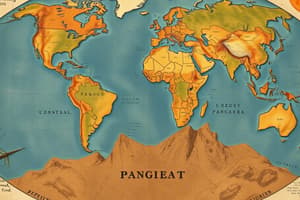Podcast
Questions and Answers
Which geological process is the primary driving force behind the movement of continents, according to the continental drift theory?
Which geological process is the primary driving force behind the movement of continents, according to the continental drift theory?
- The spreading of the seafloor due to tectonic plate movement. (correct)
- Erosion from major river systems altering continental shapes.
- Volcanic eruptions causing landmass displacement.
- The expansion and contraction of the Earth's core.
If a scientist discovered fossil evidence of the same extinct species on both the east coast of South America and the west coast of Africa, how would this support the theory of continental drift?
If a scientist discovered fossil evidence of the same extinct species on both the east coast of South America and the west coast of Africa, how would this support the theory of continental drift?
- It would imply the species was capable of long-distance oceanic travel, colonizing both continents separately.
- It would suggest the species evolved independently on both continents due to similar environmental conditions.
- It would indicate that land bridges once connected the continents, allowing the species to migrate.
- It would provide evidence that the continents were once joined, allowing the species to roam freely across both landmasses. (correct)
Before the wide acceptance of the continental drift theory, what was a common alternative explanation for the distribution of similar plant and animal fossils across different continents?
Before the wide acceptance of the continental drift theory, what was a common alternative explanation for the distribution of similar plant and animal fossils across different continents?
- The theory of punctuated equilibrium, where species rapidly dispersed across the globe during brief periods of environmental stability.
- The concept of fixism, which proposed that continents remained stationary, and species migrated via land bridges that no longer exist. (correct)
- The idea of transformational evolution, where species adapted to similar environments on different continents.
- The theory of island hopping, where species gradually colonized islands and eventually reached other continents.
How did Alfred Wegener's background in astronomy and meteorology influence the development of his continental drift theory?
How did Alfred Wegener's background in astronomy and meteorology influence the development of his continental drift theory?
Which of the following observations would most strongly challenge the theory of continental drift?
Which of the following observations would most strongly challenge the theory of continental drift?
Flashcards
Continental Drift Hypothesis
Continental Drift Hypothesis
The hypothesis that continents were once joined and have since drifted apart.
Pangea
Pangea
The large, ancient landmass that Wegener proposed contained all the continents.
Tectonic Plates
Tectonic Plates
Massive slabs of rock that move, causing continents to drift.
Alfred Wegener
Alfred Wegener
Signup and view all the flashcards
Seafloor Spreading
Seafloor Spreading
Signup and view all the flashcards
Study Notes
- The continental drift hypothesis posits that all continents were once joined in a single landmass before drifting apart to their current positions.
- Continental drift is attributed to the movement of tectonic plates, causing landmasses to separate and form continents.
- Seafloor spreading is identified as the primary driver of continental drift.
Alfred Wegener's Theory
- Alfred Wegener proposed the continental drift theory in 1912, suggesting the existence of a supercontinent called Pangea.
- Pangea fragmented approximately 250-200 million years ago, leading to the formation of the present-day continents.
- Early on, Wegener's theory faced opposition from scientists who believed continents were fixed.
Alfred Wegener's Background
- Alfred Wegener (1880-1930) is credited with introducing the theory of continental drift.
- Wegener earned a Ph.D. in astronomy from the University of Berlin in 1905.
- He later developed an interest in paleo-climatology.
- From 1924 to 1930, Wegener served as a professor of meteorology and geophysics at the University of Graz.
Development and Reception of Wegener's Theory
- Wegener first presented his theory during university lectures in 1912.
- He gathered evidence from scientific literature, noting similar fossils and rock strata on separate continents like the Americas and Africa.
- In 1915, Wegener published his theory, but it was largely rejected by geologists until the 1960s.
- Wegener's theory was eventually accepted as part of plate tectonic theories, significantly impacting the understanding of geology and continental formation.
Evidence Supporting Continental Drift
- Fossil evidence includes the discovery of Lystrosaurus fossils in Antarctica and southern Africa, indicating past land connections.
- Climate data reveals glacier grooves on multiple continents, suggesting shared glacial history.
- The "puzzle piece" fit of continents, such as the matching coastlines of South America and Africa, supports the theory.
- Rock clues from mountain ranges on different continents align when the continents are brought together, such as those in South America, Europe, and Africa.
- Similarities in rock strata and variations among continents provide additional evidence.
Unique Fossil Examples
- A whale graveyard was discovered in a desert in Chile.
- Dinosaur fossils are abundant in Drumheller, Alberta, Canada.
- Aztec dog remains were found in a mass burial site in Mexico City.
- A Pterosaur colony was found in a cave in Brazil.
- Woolly mammoth remains were discovered in a village in Siberia.
- Thousands of Jurassic turtle fossils were found in China.
Initial Rejection
- Wegener's theory was initially rejected by geologists and scientists within his academic circle.
Studying That Suits You
Use AI to generate personalized quizzes and flashcards to suit your learning preferences.




